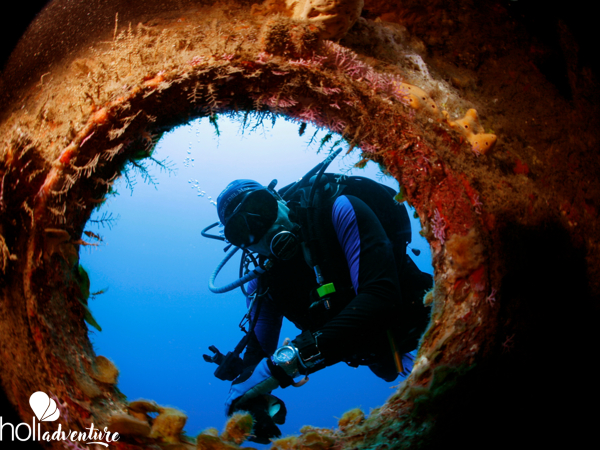General Information
- Category: Half day tours
- Modality: Nautical tours
- Duration: 4.00 hrs
- Departure time: 9:00 hrs
- Tour guide: Yes
- Children are allowed: No
- Languages spoken: Spanish, English and Italian
- Location: Campismo Río La Mula, Guamá, Santiago de Cuba.
Program Details
Scuba Diving in Wrecks of the Hispanic - Cuban and North American War of 1898. "CRISTOBAL COLÓN BATTLESHIP CRUISE"
Archaeological Park of the Natural and Cultural Underwater Heritage Battle of Santiago de Cuba Declared a National Monument in 2015.
General Description
The "Parque Arqueológico del Patrimonio Natural y Cultural Subacuático Batalla Naval de Santiago de Cuba" occupies a coastal strip of about 120 kilometers in length and was witness to the unequal combat between the squadrons of the Spanish Rear Admiral Pascual Cervera and the American Rear Admiral William Sampson, in which all the Spanish ships were annihilated ending the Spanish colonial rule in America, and giving way to the emergence of the most powerful empire in the history of mankind, the United States of America.
The place is formed by seven archaeological sites (Las Cuatro Bocas Playa Siboney, Rancho Cruz - Buey Cabón, Playa Mar Verde, Ensenada de Juan González, Aserradero and Playa La Mula), whose environmental and archaeological characteristics are different from one site to another along the southeastern coastal strip of the province of Santiago de Cuba.
The vestiges of that naval crusade make up what is currently known as the "Batalla Naval de Santiago de Cuba" Underwater Archaeological Park. In this site lie the wrecks linked to the landing and the naval conflict, as well as all those material evidences belonging to the ships that are related in one way or another to the events, such as: masts, masts, remains of the rigging of the mastheads, ironwork, parts of the artillery sites, thick and medium caliber projectiles, flushes, balusters and mechanisms of the propulsion system.
It is a true privilege to learn about history through these wrecks, exceptional witnesses to the events of the Naval War of 1898, and to enjoy diving today in an environment of spectacular beauty, where the Sierra Maestra mountain range bursts into the Caribbean in an abrupt and irregular manner, cut by canyons and riverbeds and estuaries that extend into deltas covered with pebbles and low areas, forming wetlands covered with mangroves in the shelter of virgin inlets and coves: ecosystems that support incredible biological diversity.
ARCHAEOLOGICAL SITE: "PLAYA LA MULA". Wreck: "Cristóbal Colón" Battleship Cruise
The Crucero Acorazado "Cristóbal Colón" is located in the surroundings of the La Mula settlement, west of the mouth of the Turquino River and 50.4 nautical miles from Santiago de Cuba, about 80 meters from the coast and between 12 and 37 meters deep.
Site: - Municipality: Guamá. La Mula Beach. West of the mouth of the Turquino River, municipality of Guamá, 50.4 miles from Santiago de Cuba.
Historical Background:
In 1895, Spain with the intention of reinforcing its naval fleet bought an armored cruise ship that would build the house Gio Ansaldo & Cia, and that after its acquisition, the Spanish government renamed it "Christopher Columbus", in honor of the famous admiral Genovese who 404 years before had discovered for the Spanish Crown the American continent.
The cost of the ship was 690,000 pounds sterling, and its construction took 6 months. It was at the time the most modern and efficient armored cruiser, it had 24 Niclause boilers, with 13,000 horsepower, capable of moving a steel mass of 6840 tons of displacement and achieve the impressive speed, for the time, of 21 knots.
The ship was delivered to the Spanish government on May 19, 1897, the same day of the following year it would arrive at the coast of Santiago de Cuba, its final destination.
On July 3, 1898 around 12:30 pm, Commander Díaz Moreu, with a situation, in numerical inequality and without his battery of heavy caliber cannons to face a combat in the high seas, decided to go forward to the coast and try to disembark his crew quickly, open the bilge registers, aimed at preventing it from falling into enemy hands during the naval combat of the Spanish-Cuban-American War. This could not be achieved being the last maneuver and resulted in the sinking of the ship at 13.25 hours; and the death of the entire crew.
Today, more than a century later, this armored cruiser “Cristóbal Colón” is one of the best preserved in the world, it is submerged in a deep zone, very close to the coast. Some objects from the ship, which are in our country, are exhibited in the museums of the Spanish-Cuban-American War, the Morro Castle and the Marine Museum in the Baconao Park aquarium. Other pieces are part of some private collections or are exhibited in museums abroad (United States and Spain).
TECHNICAL CHARACTERISTICS OF THE “Cristóbal Colón” BOAT
- Name of the wreck: “Cristóbal Colón”.
- Class: "Giuseppe Garibaldi".
- Type of vessel: 1st class battleship.
- Shipyard: "Sestri Ponente" of Ansaldo, Genoa, Italy.
- Launch date: July 24th, 1889.
- Flag: Spain.
- Launch date: September 16, 1896.
- Commander: Captain Emilio Díaz Moreu.
- Crewmembers: 543 men.
- Strut: 12.19 meters.
- Draft: 7.75 meters.
- Length: 100 meters.
- Beam: 18.20 meters.
- Displacement: 6,840 tons.
- Type of bow: Inverted launch.
- Decks: Steel and wood.
- Maximum speed: 20 knots.
- Range at low consumption: 8,300 miles (nautical).
- Rudder: Aft, spade outside the transom with shaft running to deck, driven by a servo motor.
- Deck armor: Deck 25 to 30 mm.
- Shielding: Stainless steel 120 to 150 mm, two thirds of the length.
- Barbets: 150 mm.
- Power : 13 000 CV.
- Type of machinery: 2 vertical triple expansion machines.
- Type of feeding: Mineral coal.
- Boilers : 14 "Niclause" boilers.
- Propulsion : 2 propellers.
- Mast: 1 mast.
- Large caliber artillery: 2 bases of the 254 mm "Amnstrong" cannons turrets, 152 mm cannons: 10 pieces.
- Medium caliber artillery: 10 guns Hotchkis Revolvers of 37 mm.
- Torpedo tubes: 5 torpedo launchers 365 mm.
- Rapid fire artillery: 120 mm cannons (rapid fire): 6 pieces. 10 Nordenfelt 57 mm guns (rapid fire).
- Machine guns "Maxims": 2 pieces.
Diving services included:
- Boat that takes you from the diving center to the diving points (In principle the dives leaving from the nautical base of the Campismo Rio La Mula will be done by diving boat when the excursion exceeds the amount of 10 divers).
- Assistance from an internationally certified instructor-guide, who will give you an informative briefing on the dive to be made.
- Basic diving equipment,
- Compressed air tank.
- Leaded belt.
Distance to travel in the excursion (round trip): 40 kms approximately.
Approximate duration of the excursion: 3 hours approximately.
Degree of difficulty: Medium.
Very important note: For safety and protection of the underwater heritage, customers may never directly touch the remains of sunken ships and must strictly comply with the instructions issued by the diving instructors.
Very important note: It is compulsory to present your official diving certificate.
Very important note: With the sea slightly moved it becomes dangerous the entrance and exit from the beach, by the frequency and intensity of the waves that break the stone slope, the possibility of falls and breakage of the equipment; in addition to possible blows and physical damages to assistant and foreign divers. It is important to point out that with the sea moving it is practically impossible to access from land.
Very important note: Although in the 27 meters (bow of the wreck) a dive can be made within the safety curve up to a time of 25 minutes, when you have a lot of volume cylinders is important to be aware of the time, decompression stops and the guidance of the instructor or guide (in the case of tourists and amateurs), as it is relatively common that some fans, engrossed in the impressive panorama, forget the essential safety standards.
TIPS: • Recommended: light clothing, swimsuit, towels, sunglasses, hat, sunscreen and photographic camera. • We recommend that the client can bring their own diving mask. • The client can bring his complete diving equipment if he wants to. • We recommend that the client can bring his/her personal dive computer. • We recommend that the client can bring one or more bottles of mineral water to stay hydrated as well as light foods rich in protein or fruit.
- The boat is shared.
- A minimum of 5 divers is required for the excursion. Holiadventure will reconfirm 48 hours before the departure of your tour. If the provider decides to cancel, for not meeting the minimum required amount of passengers, Holiadventure will offer an alternative tour or fully refund cost of your trip.
- Transportation not included in the services of the diving excursions in Santiago de Cuba. The client must arrive at the Marina Marlín in Punta Gorda by his own means 30 minutes before the indicated time of the excursion.
- The excursion can be cancelled in an unexpected way if the general weather conditions and especially in the sea advise it. This does not imply any responsibility or penalty for the agency and the marina company offering the service. In principle we will try to change the date of the excursion for the following days when the conditions improve. If this is not possible, we will proceed to refund the total value of the excursion paid by the client previously.
- The client must present a valid diving certificate issued by an internationally recognized diving organization.
- The client must sign a waiver of responsibility for diving as a risky activity, releasing the agency and the marine company offering the service from any legal responsibility, before leaving for the excursion.













